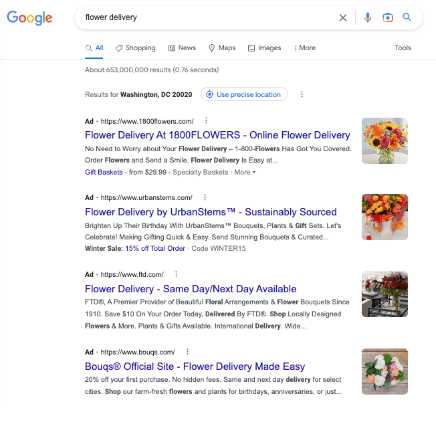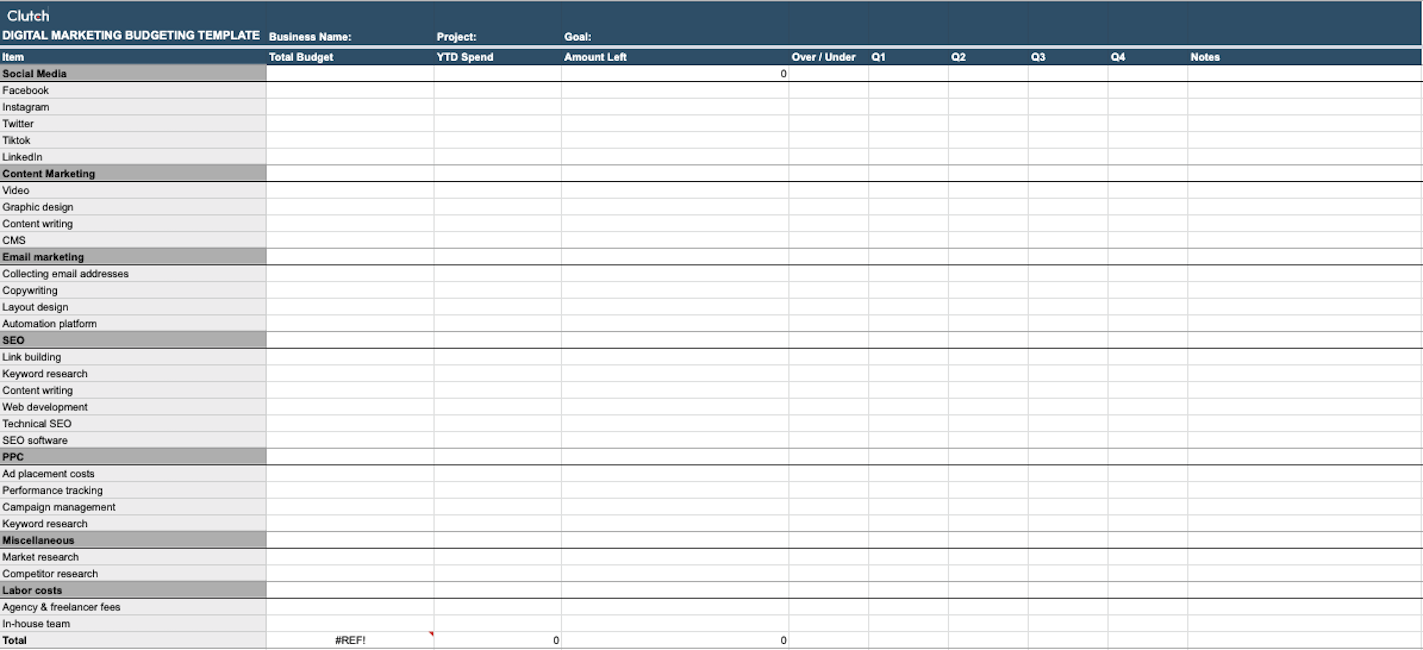

Updated December 16, 2025
Want to grow your business online? Digital marketing can help you connect with customers, increase sales, and strengthen your brand’s image. Get started by creating a digital marketing budget that suits your financial plan.
Americans spend hours online every day, making digital marketing one of the most effective ways for businesses to connect with them. Through different online channels, marketers are able to connect with audiences, convey brand messaging, and advertise products or services.
With many different digital marketing channels and strategies, you can create a digital marketing plan that fits your budget — regardless of your company’s size. Here’s what you need to know to create a digital marketing budget for your business.
Looking for a Digital Marketing agency?
Compare our list of top Digital Marketing companies near you
Looking to enhance your online presence? Connect with a digital marketing company on Clutch.
Digital marketing is a broad term that encompasses various strategies used to promote a business, organization, or website online. What you need to budget for depends on which digital marketing channels you’ve invested in. Here’s what each entails so you can determine how to budget for each one:
Of course, most businesses use a combination of digital marketing strategies in order to achieve the results they're looking for. With a solid understanding of how each type of digital marketing can help grow your business, as well as how much they cost, you can create a digital marketing strategy that is effective and fits your budget.
Most digital marketing experts recommend that brands spend roughly 7%–10% of their overall revenue on digital marketing. Of course, this means that there can be a huge discrepancy between what businesses are spending on their marketing efforts. Larger businesses that have more revenue can afford to spend more on their budget than smaller businesses.
Keep in mind, this is a good strategy for maintaining your business’s financial health — you certainly don’t want to overspend on marketing.
However, how much businesses spend on marketing may depend on the industry that they’re in. For example, the cost per click (CPC) for keywords in the medical and home services industries are notoriously high, especially in comparison to industries such as the food and beverage industry. These costs drive up the budget for PPC campaigns in those industries. As such, companies in more competitive industries may need to allocate more to their digital marketing budget than others.
While the upfront costs of digital marketing can be frustrating, a well-run campaign can deliver a positive return on investment (ROI). This means that businesses will make more money from their marketing efforts than they spend on it.
How much your business should allocate to digital marketing depends on your financial health as well as your industry, target audience, and the lifetime value of an acquisition.
In order to allocate where your marketing budget will be spent, your entire team must be aligned on your business’s priorities. What goals are your marketing efforts supporting? You want to make sure that your marketing goals align with the business’s strategic vision for growth.
These goals will help you understand which digital marketing channels you want to invest in. For example, If you want to build credibility online, content marketing would be a great digital marketing option for your business, but if you want to increase sales, social media ads may be a better fit.
How much you end up budgeting for marketing may depend on the digital marketing channel you end up employing. SEO, for instance, doesn’t require any ad spend, whereas PPC campaigns do. Therefore, businesses that invest in PPC also have to account for what they’re spending to place an ad.
Similarly, email marketers need to account for the cost of an email marketing platform (such as Mailchimp), while content marketers may need to hire graphic designers or writers to develop content. How their budget should then be divided up depends entirely on the scope of the project.
Be sure to prioritize each goal as well; if you are managing multiple digital marketing channels, you will need to determine how much of your budget you can allocate to each one. Depending on your goals, you may want to invest 50% of your digital marketing budget on SEO, 25% on social media, and another 25% on PPC. How would that impact the rest of your budget?
Eventually, you will use your business goals to establish key performance indicators (KPIs). They will help you measure the impact of your digital marketing efforts. This can include:
While this is important mostly so you can track the success of your campaigns, it may also have a big impact on your marketing budget. If your campaigns are doing well, it’s easy to use this data to demonstrate that digital marketing is worth the expense. It may even give you leverage when negotiating your budget in the future.
Additionally, how your digital marketing efforts have performed in the past can help you create your strategy going forward. It would be foolish to create a digital marketing budget without data to back it up. If your company has run digital marketing efforts in the past, it’s important to review what has and has not done well.
For one, this information can help you determine which strategies to continue (or discontinue) in the upcoming quarter. If you haven’t seen any impactful results from a PPC campaign on Facebook, it may be time to reassess your strategy rather than dumping more money into the platform.
The results you’ve seen in the past can also help you predict how effective your campaigns are and forecast earnings. A standard model to calculate conversions is:
Audience size x CTR x Conversion Rate = # of Conversions
Then compare the revenue from those conversions to your marketing budget to determine the value of your marketing efforts. If you spent $10,000 on a social media campaign last quarter, resulting in $20,000 in revenue, you may want to invest more in that marketing channel in the future.
With an understanding of how effective each channel is, you can determine how your budget should be allocated.
As we discussed above, how you allocate your digital marketing budget depends on the channels your business has invested in. Here are a few things you should include in your budget, depending on the channels you’ve chosen:
Social Media Marketing (SMM)
Content Marketing
Email Marketing
Search Engine Optimization (SEO)
Pay-Per-Click (PPC)
Search Engine Marketing (SEM)
Be as thorough as you can when thinking through each process. How much you spend is variable depending on the audience you’re trying to reach, how competitive your industry is, how long your campaign will run, and much, much more.
The more detailed you are, the more accurate your budget will be and the less likely you will be surprised by unexpected costs.
To understand everything you need to account for when creating a digital marketing budget, let’s consider what goes into creating a PPC budget.
A Washington DC flower shop wants to run a Google Ad. They choose to target the word “flower delivery.” However, the cost per click for this keyword is $6. This means that if 10,000 people click on their ad, they will be charged $60,000.

The good news is that Google Ads allow businesses to choose a daily budget, so small businesses like this don’t end up overspending. They could limit their ad spend to just $60, so once they get 10 clicks, their ad won’t appear on SERPs anymore.
Whether they plan to spend $60 or $60,000, the ad spend needs to be included in the budget.
They also may want to hire a photographer to take pictures of their flowers to include in the ad, so that needs to be included in the budget as well.
This budget should also include the salaries of any internal team members managing the campaign, as well as the tools they need. Tools like Ahrefs can help companies find keywords they want to target and estimate the cost per click, but subscription prices start at $99 per month.
Keep all of these expenses in mind when estimating your digital marketing costs.
It’s surprisingly easy to overlook certain costs when building your digital marketing budget. To get a truly accurate picture of how much it costs to grow your digital marketing efforts, you need to account for all of it. Here’s what you need to remember when compiling your budget:
All of these expenses are necessary in order to meet your digital marketing goals, and need to be included in your budget.
Throughout the quarter or year, things may come up that would require extra spending. Whether you need to hire another freelancer to keep up with the demands of your content calendar or you want to bring in a new tool to help you optimize your campaigns, you don’t want to feel limited based on your budget. By building in a little extra room into your budget, you can seize these opportunities as they come up.
Once you’ve outlined your budget, you’ll need to funnel it up to upper management for feedback and approval. It can be helpful to provide the data and reasoning behind your budget to ensure that it is approved. By tying it in with your company’s business goals, you will provide extra value to your leaders and decision makers.

Download the Digital Marketing Template for Your Budget
The cost of your digital marketing efforts can vary. Here are a few things to consider when developing your digital marketing budget.
By considering these factors, you will be able to create a more accurate budget for your digital marketing efforts.
Digital marketing can be an extremely effective way for companies to connect with customers and grow their business online. However, if they don’t manage their digital marketing budget well, it’s easy to overspend, resulting in a low return on investment.
By strategically outlining how they plan to divvy up their digital marketing budget, they can keep costs low and still see the impact of their marketing efforts.


